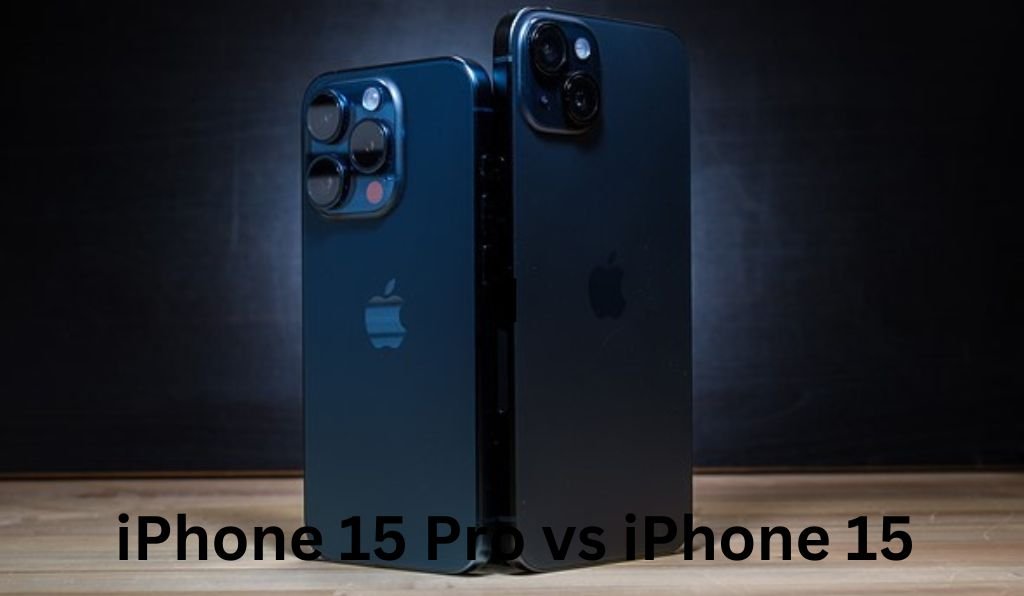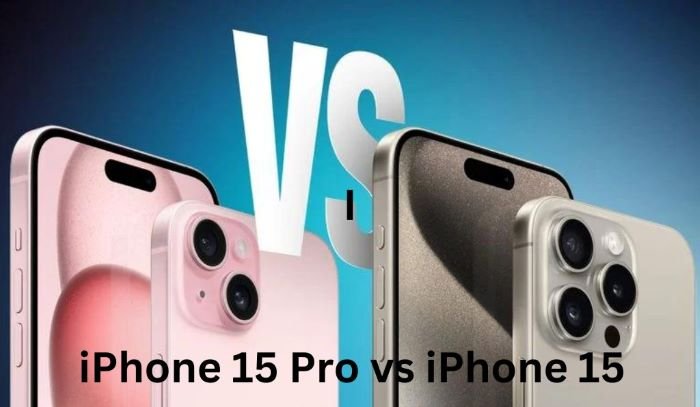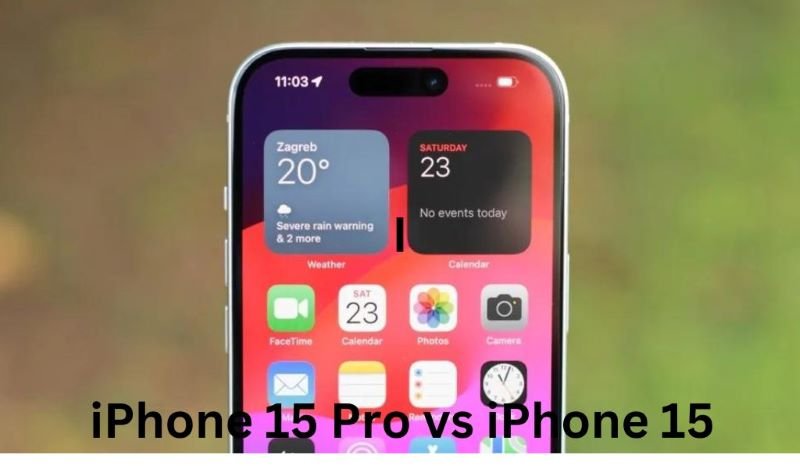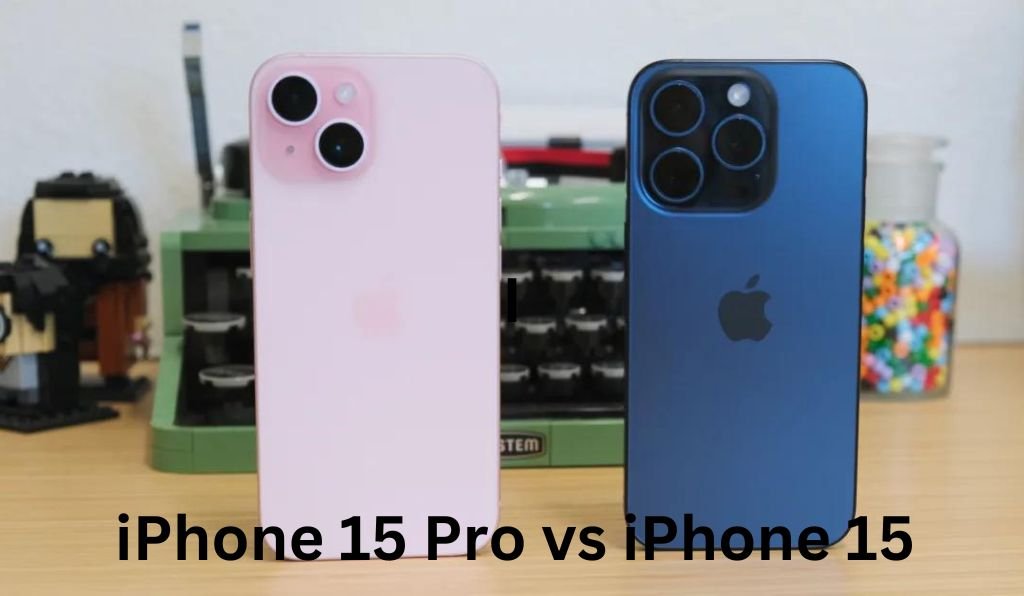iPhone 15 Pro vs iPhone 15 range comprises four variants, each with pros and cons, following the same pattern that Apple has been using for the past few years. Although having options is advantageous, it also forces you to choose which iPhone 15 is best for you.
When comparing the iPhone 15 Pro vs iPhone 15, it could initially seem like the only changes are in the color selections and cameras. However, upon closer inspection, you’ll find that there are a few crucial characteristics that have the potential to tip the scales in favor of one phone over the other.
In an effort to assist you in selecting the phone that’s best for you, I’ll go over the features, benefits, and practical experience of both models.
Differences between the iPhone 15 Pro vs iPhone 15 at a glance:
$1,000 vs $800 as the beginning cost
Improved A17 Pro (3nm) chip compared to A16 (4nm)
Both have 6.1″ screens, but the 15 Pro’s bezels are thinner
Refresh rate is 120Hz instead of 60Hz.
The 15 Pro sports a 3X zoom lens.
Pro offers 20X higher USB transfer speeds and marginally faster charging.
The Action Button is in Pro.
Table of Contents:
• Display and Design
• Camera
• Performance and Battery life
• Audio Quality
• Summary
Design and Display Quality:

At last, Apple decreases the iPhone 15 Pro’s weight to match that of the standard model. The 15 Pro also receives a redesigned Action button and thinner screen borders.
Compared to the Pro Maxes and Ultra phones of the world, the iPhone 15 Pro vs iPhone 15 both have 6.1-inch screens, making them relatively small phones. They are clearly not as tiny as the iPhone mini, but they are generally manageable with one hand and occasionally will need a double grip.
Despite having the identical screen sizes, the 15 Pro is physically slightly narrower and has slimmer bezels, giving it a more contemporary edge-to-edge design. Thus, it’s a little bit simpler to handle, though we noticed that when we use the phone without a case in the current winter cold, the matte frame and the titanium itself can feel a little slippery against dry hands.
So you can see the iPhone 15 Pro vs iPhone 15 the iPhone 15 Pro weighs a little bit more than the previous models, but not by much. Our favorite new feature of the Pro is really how much lighter it has become.
This is because the new titanium frame—which was previously made of stainless steel is to blame. Although much lighter, titanium is just as strong. Nevertheless, it’s important to remember that the iPhone 15 Pro’s frame is made of aluminum on the inside, with a titanium outer shell welded to it measuring just 0.04 of a millimeter. You do receive the benefit of titanium’s reduced fingerprints and dent resistance despite this hybrid method.
In contrast, the standard iPhone 15 model has a well-known aluminum frame that is notably softer than titanium while still ensuring the phone is lightweight and manageable. It also comes in a range of vibrant hues, whereas the titanium models only offer a few subdued choices.
It’s interesting to note that the back of the standard iPhone 15 is now made of smooth matte glass instead of the glossy finish found on earlier vanilla iPhone models. The matte glass on the rear of the 15 Pro versions is actually quite similar to the back of the iPhone 15.
The new Action Button is a feature exclusive to the iPhone 15 Pro, the standard iPhone 15 still uses the trusty mute switch. You may program the new Action button to do a variety of functions. By default, it functions as a mute key, but with the help of the Shortcuts app, you can configure it to launch the camera, launch any program, or perform more complicated tasks. The standard iPhone 15’s mute switch just isn’t capable of doing that.
However, it should be noted that the Action Button has a single function. It can only be used with the press and hold gesture, which you can associate with any app or function you choose. Thus, you forfeit the on-demand muting feature if you decide to have the Camera attached to the Action Button. Fortunately, the Control Center (swipe down from the top-right of the display) has a new Mute toggle.
Both phones have a USB-C port on the bottom, which is a nice upgrade over the Lightning port that Apple has been using for many years. The good news is that you won’t need to bring extra cables because most other electronics also use the same cable.
The standard iPhone 15 is still only capable of USB 2 rates (0.5Gbps), whereas the 15 Pro is the sole device that can utilize this connector to achieve faster USB 3 transfer speeds of up to 10Gbps. Now, this won’t be a problem if you don’t frequently need to transfer files via a cable, which is presumably why the capability is only available on the Pro model.
However, even if you purchase the Pro model, the cable that comes with the iPhone 15 Pro boxes does not support USB 3 transfer rates, so you will need to acquire a USB 3 compliant cable separately to take advantage of the quicker speeds.
Fortunately, an Apple-branded cable is not required for that. Any USB 3 cable will work; we checked the iPhone 15 Pro’s USB 3 transfer speeds here, verifying the speeds Apple promises its new Pro iPhones can reach and concluding that uploading data to the cloud was no longer the only way to move files from your iPhone.
In case you were wondering, both phones have the same IP68 water and dust certification when it comes to design.
The iPhone 15 Pro vs iPhone 15 screens come next. Both of these iPhones have 6.1″ OLED panels, and although the resolution and color quality are similar, the standard iPhone 15 lacks a crucial feature: 120Hz ProMotion! We’re not sure how long Apple will continue to use a 60Hz screen on the standard versions, but we do know that the iPhone 15’s scrolling still seems a little choppy in comparison to the 15 Pro’s seamless experience.
The Camera is closer than ever:

With two rear-facing cameras, the iPhone 15 offers three different zoom options: 0.5x ultrawide, 1x standard, and 2x zoom, the latter of which is typically only available on iPhones with three rear cameras. Through software tricks, Apple is able to capture two times as many images with the 48-megapixel main camera’s sensor—just enlarging them. Zoom levels on the iPhone 15 range from 0.5x to 10x.
Three cameras are located on the back of the iPhone 15 Pro, a 12-megapixel ultrawide camera, a 12-megapixel telephoto camera, and a 48-megapixel primary camera. With a maximum zoom level of 15x, up from the 15’s 10x, the 15 Pro offers you preset zoom options of 0.5x, 1x, 2x, and 3x thanks to identical software methods that allow it to utilize the larger main camera’s sensor. The iPhone 15 Pro Max has a 5x optical zoom and a maximum 25x digital zoom if you’re looking for something with more magnification.
More digital and optical zoom choices are available to you, along with enhanced optical image stabilization, night mode portrait photography, a macro photography mode, and support for Apple’s ProRAW picture format for additional editing options on the 15 Pro.
While the iPhone 15 Pro vs iPhone 15 have comparable video recording functionality, the iPhone 15 Pro supports ProRes video in addition to offering more sophisticated features like macro video mode and log video recording. With the macro video mode, you may concentrate in on an object at a close distance, such as an insect or flower.
The only difference between the two front-facing cameras is that the 15 Pro has the additional capability to shoot video in ProRes.
The bulk of iPhone users won’t be able to benefit from these sophisticated video technologies, such as ProRes and Log video recording, which provide professional filmmakers additional tools and options to fine-tune and modify colors in video produced in those formats.
Although the iPhone 15 Pro’s camera technology is more powerful and flexible than the regular 15’s, neither phone produces particularly subpar images. As a matter of fact, the current performance of both camera systems is unprecedentedly identical. Both phones provide you with high-resolution photos and several optical zoom settings.
The option to use Focus and Depth Control to snap a regular image and then turn it into a portrait later on is one function that I still find unbelievable isn’t exclusive to the iPhone 15 Pro. The iPhone must recognize a person or animal in the picture, or you must tap the screen to set a focus point, for the functionality to function. The iPhone will further record depth information in addition to the picture when one of those circumstances is satisfied.
After that, you can alter the image to make it a portrait or shift the focal point to something in the background or foreground.
Due to camera differences, I hardly ever gave the basic iPhone models much thought before the release of the iPhone 15. However, given the camera configuration of the 15 and 15 Pro, I would be equally content with any phone. There isn’t much of a difference until you start comparing either phone to the iPhone 15 Pro Max.
TL;DR: With its enhanced zoom and overall clarity, the iPhone 15 Pro’s camera is the best one available for an iPhone as of yet. Nevertheless, the iPhone 15’s camera is rather good, and you’ll be pleased with the results if your primary use for it is to take and post pictures to social media.
performance and battery life:

Apple’s A16 Bionic processor, which was also utilized in the iPhone 14 Pro series from the previous year, powers the iPhone 15. Even if the technology is outdated, it is still incredibly quick and capable of handling iOS 17 and all of its features. The RAM capacity of any iPhone is not disclosed by Apple, yet Geekbench 6 indicates that the iPhone 15 has 6GB of memory. 128GB, 256GB, or 512GB of storage are available; they cost $799, $899, and $1,099, respectively.
Utilizing Apple’s most recent processor, the A17 Pro, the iPhone 15 Pro is faster overall and boasts one extra GPU core than the A16 Bionic—a crucial feature for gamers. The 15 Pro costs $999, $1,099, $1,299, and $1,499, respectively, and has 8GB of RAM and storage options of 128GB, 256GB, 512GB, or 1TB.
The iPhone 15 Pro is the undisputed winner if benchmarks were used to compare the two phones’ performance in an objective manner. The 15 Pro achieves an average single-core score of 2,915 and an average multi-core score of 7,213 on the CPU test conducted by Geekbench 6. An average single-core score of 2,595 and a multi-core score of 6,510 are obtained when the same test is run on the iPhone 15.
These results suggest that the iPhone 15 Pro offers superior single-core performance, which you’ll probably use for everyday chores like social media scrolling that don’t require a lot of processing power. The A17 Pro’s multi-core enhancement will be most noticeable when gaming or performing resource-intensive tasks like photo or video editing. It’s also important to note that the iPhone 15 Pro has exclusive access to a few high-end console games, such as Assassin’s Creed Mirage, Resident Evil Village, and Death Stranding, which are set to release soon thanks to its improved processing.
However, I haven’t observed a significant difference in performance between the two phones when I use them as I usually do, which is to check email, read news, idly peruse social media, chat in the Messages app, and shoot a few random photos. If I had to pick faults, I’d have to say that the 15 Pro seems to start programs a little quicker, applies photo changes more quickly, and occasionally takes a few less seconds to load games.
According to Apple’s official estimations, the iPhone 15 can play videos for up to 20 hours, while the iPhone 15 Pro can do it for up to 23 hours.
Similar results have been observed in my use of both phones, with the iPhone 15 Pro typically having a few percent more battery remaining at the end of the day than the iPhone 15.
TL;DR: The performance and battery life of both phones are comparable. The 15 Pro is the best option if you play games a lot or wish your present phone had a longer battery life. The performance of the 15 is excellent otherwise.
iPhone 15 Pro vs iPhone 15 Audio Quality:
These share identical technology, including a bottom-firing speaker and an amplified tweeter in the earpiece, but the iPhone 15 Pro model sounds somewhat better than the standard iPhone 15—the regular iPhone 15 has a little bit less “punch” and the highs are slightly less crisp. By no means is it a significant change, but when we listened carefully, we did notice it.
As anticipated, neither of these includes a headphone jack. However, note that wired headphones can be connected to USB C devices using the new USB-C port.
There’s also no difference in the haptics arena. Both phones have Apple’s long-standing Taptic Engine, which offers a clicky feel and excellent response speed.
summary:
This year, iPhone owners found it extremely difficult to choose between iPhone 15 Pro vs iPhone 15 thanks to Apple, One might make a strong case for the iPhone 15 being the most “pro” entry-level model to date. Because of this, it’s a good option for many people, particularly because it will save you a few hundred dollars.
The iPhone 15 Pro’s always-on display, new Action Button, titanium shell, beefier processor, and additional camera configuration, however, make it well worth the $999 price tag if you prefer to own the newest and finest iPhone.




One thought on “iPhone 15 Pro vs iPhone 15: which one is Right for You?”